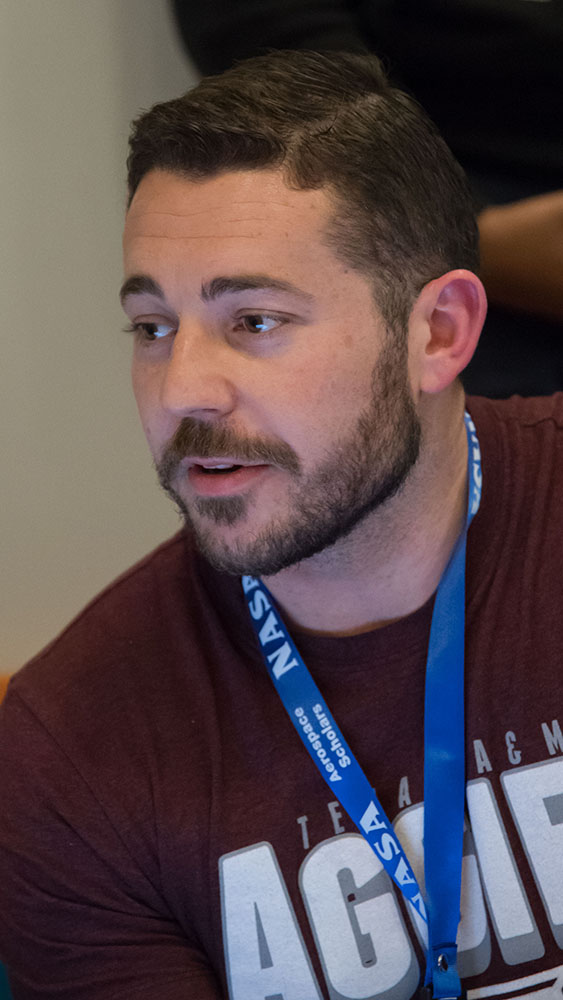
Blaze Belobrajdic, student veteran and aerospace engineering graduate student at Texas A&M University, was named a 2019 Tillman Scholar by the Pat Tillman Foundation in recognition of his service, leadership and potential.
When asked what being named a 2019 Tillman Scholar meant to him, Belobrajdic said, “It means a heightened sense of responsibility to my family, community, school and service. Pat Tillman, despite every other opportunity he had, decided to join the U.S. Army, become a Ranger and fight in the war on terror. He raised his right hand, when so many others did not, and is now recognized as a paragon of sacrifice toward a noble cause. Part of that responsibility is carrying forward his legacy and I pray I live up to the standards the Pat Tillman Foundation represents.”
Belobrajdic began his military career in 2001 as a midshipman in the United State Naval Academy. After the events of Sept. 11, 2001, he sought a more active role, and in 2005 commissioned in the U.S. Marine Corps to become a helicopter pilot. Belobrajdic spent 12 years as a UH-1Y pilot, deployed three times to Afghanistan in support of Operation Enduring Freedom, and once while attached to Special Operations Command-Africa. He also served as a fleet readiness squadron instructor pilot and the squadron’s director of safety and standardization.

After leaving the military, Belobrajdic chose to come to Texas A&M to pursue his master’s degree in aerospace engineering. “Texas A&M has a great reputation, my brother is in attendance and the Aggie Veteran Network is extremely helpful,” said Belobrajdic. “It is a great fit.”
In Belobrajdic’s first year at Texas A&M, he worked with Dr. Darren Hartl on shape memory alloy (SMA) morphing radiator research. While on Hartl’s team, he became a project mentor for the SMA tourniquet project. “The idea being a tourniquet that could remotely activate and apply critical life-saving pressure quickly was a project I had to be involved in,” said Belobrajdic.
Hartl introduced Belobrajdic to Dr. Ana Diaz Artiles, director of the Bioastronautics and Human Performance research group in the aerospace engineering department, and through her, he found subject matter that he became even more passionate about.
During the summer of 2018, he interned at NASA’s Human Systems Engineering and Integration Branch at the Johnson Space Center in Houston. The branch focuses on integrating aerospace and industrial engineering with humans in space flight. While interning, Belobrajdic decided he wanted to continue his summer’s work in his graduate research.
Artiles and Belobrajdic completed a review of where spacesuits are today technologically, and what problems still need to be solved for exploration of the Moon and Mars. Next, they will look at cataloging Earth’s analog environments for use in extra-vehicular activity, or research spatial disorientation and cognitive loading and their effect on situational awareness.
A single dad, Belobrajdic wants to set a good example for his daughter. After completing his degree, he looks to start a business that analyzes statistical data associated with military helicopter crashes and creates training protocols, procedures and technology to mitigate the human factors associated with the loss of situational awareness. He would also love to work at NASA and throw his name into the ring for the next astronaut selection. And finally, he would like to establish a non-profit aimed at building community and strengthening relationships.
Belobrajdic hopes to bring veterans and the local community together by establishing town hall forums to encourage people to interact and share their unique experience as a way of communal restoration for veterans. “Part of the responsibility I feel is to build positive relationships between people with disparate backgrounds in my community,” said Belobrajdic. “Allowing veterans to come forth to a microphone, provide an introduction and allow their experiences to be heard may give folks in the community (that did not deploy) some perspective on life in a combat zone.”
The Pat Tillman Foundation was established after the April 2004 death of Pat Tillman, an NFL athlete with the Arizona Cardinals. Tillman put his NFL career on hold to enter the military, and died while serving with the 75th Ranger Regiment in Afghanistan.
The foundation supports active duty service members, veterans and military spouses by investing in their education and professional development. Tillman Scholars receive more than $1.2 million in scholarships to pursue higher education and continue their service in their respective fields.